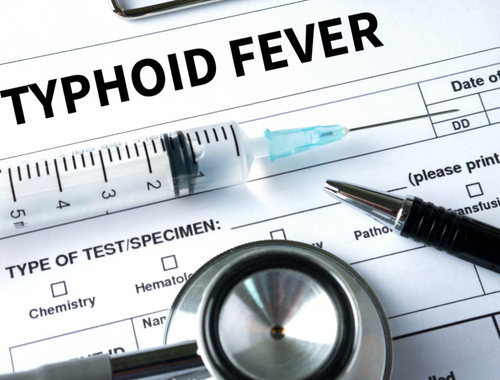Difference Between Malaria and Typhoid Symptoms
Malaria symptoms are indications you have been infected with Plasmodium. Typhoid symptoms are indications that you have been infected with Salmonella typhi bacteria.

What are Malaria symptoms?
Definition:
Malaria symptoms are signs that you have this disease which is caused by a protozoan known as Plasmodium.
Symptoms:
There are many symptoms associated with malaria. These include having malarial paroxysms where the person feels cold and shivers then develops a high fever. They also often develop an enlarged spleen and liver and have anemia. Other symptoms include a low blood platelet count (thrombocytopenia) and the white blood cells (leukocytes) often appear abnormal. They may also develop jaundice, abdominal pain, diarrhea, and sweating.
Complications:
Complications are most common with falciparum malaria (i.e., malaria caused by P. falciparum). Patients with this illness can have seizures and end up in a coma. It can cause death and malaria, in general, has a mortality rate of about 15.3 per 100,000 cases.

What are Typhoid symptoms?
Definition:
Typhoid symptoms are signs you may have the infection, which is caused by Salmonella typhi bacteria.
Symptoms:
Signs that a person has typhoid include gastrointestinal issues such as constipation or diarrhea. Belly pain is commonly present and a high fever remains for about 10 days. The spleen enlarges and often liver function is altered. The patient with typhoid often develops a skin rash that consists of small red dots and this rash is found on the abdomen and chest. Disseminated intravascular coagulation and anemia are also symptoms that can occur in patients with typhoid.
Complications:
Typhoid can be very dangerous leading to complications like intestinal perforation and peritonitis. Left untreated typhoid fever can be deadly.
Difference between Malaria and Typhoid symptoms?
Definition
Malaria symptoms are the signs that you have been infected with Plasmodium. Typhoid symptoms are the signs that you have been infected with Salmonella typhi.
Incubation period
The incubation varies for malaria depending on the type of Plasmodium, and this can vary from 12 days to up to a year. The incubation for typhoid is from 6 days to 1 month.
Digestive system symptoms
Diarrhea, pain in the abdomen, and nausea occur with malaria. Diarrhea or constipation and stomach pain occur with typhoid.
Organ signs
In the case of malaria, the liver and spleen are both enlarged. In the case of typhoid, the spleen is enlarged and liver function tests are not normal.
Type of fever
People with malaria typically have a high fever of 102 oF to 105oF and also rigors (malaria paroxysms). People with typhoid have a high fever of 102 oF to 104oF with no change for about 10 days and no rigors are present.
Skin color or rash
In the case of malaria, patients may develop jaundice (yellow skin color) but no rash. In the case of typhoid, patients often develop a particular type of rash but no jaundice.
Blood cells
Anemia and low blood platelet counts and atypical leukocytes are typical of malaria cases. Anemia and possibly disseminated intravascular coagulation are present in patients with typhoid.
Table comparing Malaria and Typhoid symptoms

Summary of Malaria Vs. Typhoid symptoms
- Malaria and typhoid are both dangerous illnesses that can lead to death.
- Malaria symptoms include jaundice while typhoid symptoms include a rash on the skin.
- Both conditions can have similar digestive system symptoms and can cause anemia.
FAQ
How is typhoid different from malaria?
Typhoid is caused by a bacterium while malaria is an illness that is caused by a protozoan organism.
Can typhoid be confused with malaria?
Typhoid fever can be confused with malaria in the early stages of the illness when the symptoms of both conditions are very similar.
How do you know if you are suffering from typhoid?
Besides the digestive symptoms, the fever does not go away and remains high for some time. This is different from illnesses like malaria.
How are typhoid and malaria diagnosed?
Typhoid fever can be diagnosed with a blood test and culture of the bacteria. Malaria can be diagnosed using a malaria antigen test.
What is different between malaria and fever?
Malaria is an illness caused by a parasite that has a fever as a symptom. Fever is simply an elevated body temperature. Typhoid is sometimes called typhoid fever due to the high fever.
How do you confirm malaria?
A blood smear can be examined under a microscope and the parasites will be evident in the blood cells.
How many days will typhoid fever lasts?
The fever associated with typhoid lasts at least 10 days but many of the symptoms improve after a couple of days with antibiotic treatment. The illness often lasts about 3 weeks and can worsen if untreated.
What are the 3 stages of malaria?
In humans: the parasite first enters the liver cells, then burst out of these and enters the red blood cells. The final stage is the parasite developing into the stages for sexual reproduction.
- Difference Between Rumination and Regurgitation - June 13, 2024
- Difference Between Pyelectasis and Hydronephrosis - June 4, 2024
- Difference Between Cellulitis and Erysipelas - June 1, 2024
Search DifferenceBetween.net :
Leave a Response
References :
[0]Bush, Larry M. and Maria T. Vazquez-Pertejo. “Typhoid fever”. Merckmanuals. Merck & Co., 2022, https://www.msdmanuals.com/professional/infectious-diseases/gram-negative-bacilli/typhoid-fever
[1]Cunha, Burke A. "Malaria or typhoid fever: A diagnostic dilemma?" The American journal of medicine 118.12 (2005): 1442-1443.
[2]Pearson, Richard D. “Malaria”. Merckmanuals. Merck & Co., 2020, https://www.msdmanuals.com/professional/infectious-diseases/extraintestinal-protozoa/malaria
